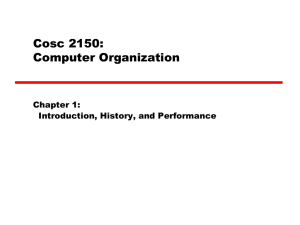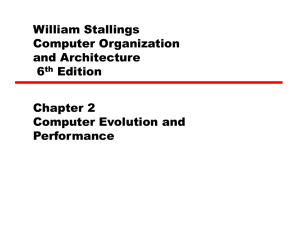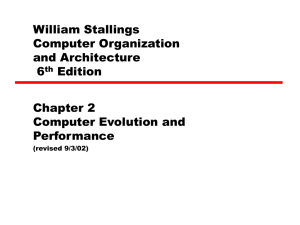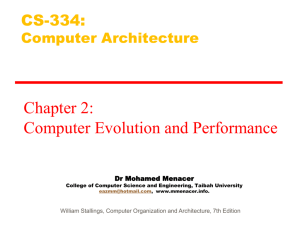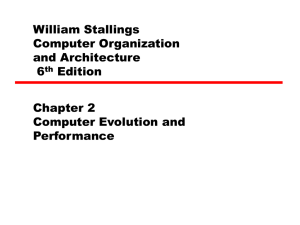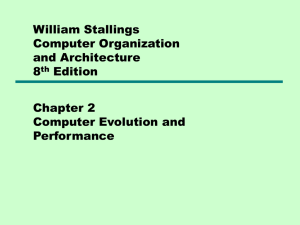02_Computer_Evolution_and_Performance
advertisement
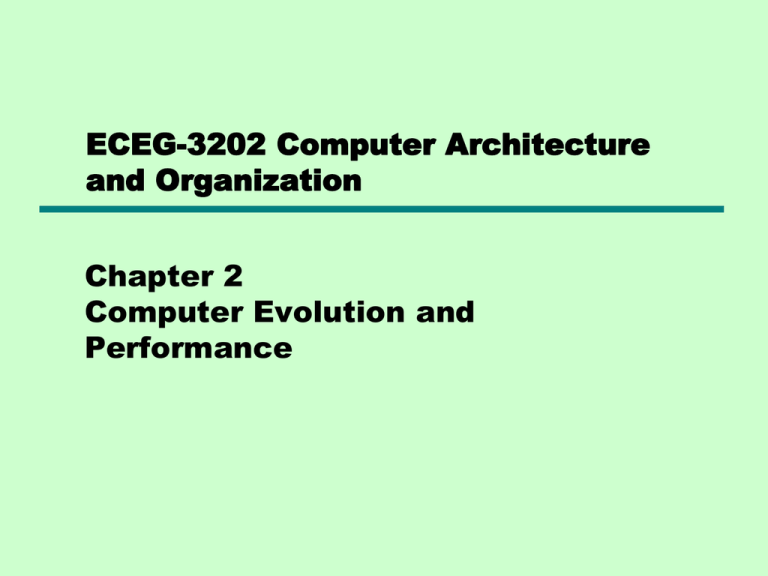
ECEG-3202 Computer Architecture and Organization Chapter 2 Computer Evolution and Performance ENIAC - background • Electronic Numerical Integrator And Computer • Eckert and Mauchly • University of Pennsylvania • Trajectory tables for weapons • Started 1943 • Finished 1946 —Too late for war effort • Used until 1955 ENIAC - details • • • • • • • • Decimal (not binary) 20 accumulators of 10 digits Programmed manually by switches 18,000 vacuum tubes 30 tons 15,000 square feet 140 kW power consumption 5,000 additions per second von Neumann/Turing • • • • Stored Program concept Main memory storing programs and data ALU operating on binary data Control unit interpreting instructions from memory and executing • Input and output equipment operated by control unit • Princeton Institute for Advanced Studies —IAS • Completed 1952 Structure of von Neumann machine IAS - details • 1000 x 40 bit words —Binary number —2 x 20 bit instructions • Set of registers (storage in CPU) —Memory Buffer Register —Memory Address Register —Instruction Register —Instruction Buffer Register —Program Counter —Accumulator —Multiplier Quotient Structure of IAS – detail Commercial Computers • 1947 - Eckert-Mauchly Computer Corporation • UNIVAC I (Universal Automatic Computer) • US Bureau of Census 1950 calculations • Became part of Sperry-Rand Corporation • Late 1950s - UNIVAC II —Faster —More memory IBM • Punched-card processing equipment • 1953 - the 701 —IBM’s first stored program computer —Scientific calculations • 1955 - the 702 —Business applications • Lead to 700/7000 series Transistors • • • • • • • • Replaced vacuum tubes Smaller Cheaper Less heat dissipation Solid State device Made from Silicon (Sand) Invented 1947 at Bell Labs William Shockley et al. Transistor Based Computers • Second generation machines • NCR & RCA produced small transistor machines • IBM 7000 • DEC - 1957 —Produced PDP-1 Microelectronics • Literally - “small electronics” • A computer is made up of gates, memory cells and interconnections • These can be manufactured on a semiconductor • e.g. silicon wafer Generations of Computer • Vacuum tube - 1946-1957 • Transistor - 1958-1964 • Small scale integration - 1965 on —Up to 100 devices on a chip • Medium scale integration - to 1971 —100-3,000 devices on a chip • Large scale integration - 1971-1977 —3,000 - 100,000 devices on a chip • Very large scale integration - 1978 -1991 —100,000 - 100,000,000 devices on a chip • Ultra large scale integration – 1991 —Over 100,000,000 devices on a chip Moore’s Law • Increased density of components on chip • Gordon Moore – co-founder of Intel • Number of transistors on a chip will double every year • Since 1970’s development has slowed a little — Number of transistors doubles every 18 months • Cost of a chip has remained almost unchanged • Higher packing density means shorter electrical paths, giving higher performance • Smaller size gives increased flexibility • Reduced power and cooling requirements • Fewer interconnections increases reliability Growth in CPU Transistor Count IBM 360 series • 1964 • Replaced (& not compatible with) 7000 series • First planned “family” of computers —Similar or identical —Similar or identical —Increasing speed —Increasing number terminals) —Increased memory —Increased cost instruction sets O/S of I/O ports (i.e. more size • Multiplexed switch structure DEC PDP-8 • • • • • 1964 First minicomputer (after miniskirt!) Did not need air conditioned room Small enough to sit on a lab bench $16,000 —$100k+ for IBM 360 • Embedded applications & OEM • BUS STRUCTURE DEC - PDP-8 Bus Structure Semiconductor Memory • 1970 • Fairchild • Size of a single core —i.e. 1 bit of magnetic core storage • • • • Holds 256 bits Non-destructive read Much faster than core Capacity approximately doubles each year Intel • 1971 - 4004 —First microprocessor —All CPU components on a single chip —4 bit • Followed in 1972 by 8008 —8 bit —Both designed for specific applications • 1974 - 8080 —Intel’s first general purpose microprocessor • Designing for performance Speeding it up • Microprocessor speed • chipmakers fabricate chips of greater density and then speed and the processor designers come up with techniques that use the higher speed • Pipelining • On board cache • On board L1 & L2 cache • Branch prediction • Data flow analysis • Speculative execution Performance Balance • Processor speed increased • Memory capacity increased • Memory speed lags behind processor speed Login and Memory Performance Gap Solutions • Increase number of bits retrieved at one time —Make DRAM “wider” rather than “deeper” • Change DRAM interface —Cache • Reduce frequency of memory access —More complex cache and cache on chip • Increase interconnection bandwidth —High speed buses —Hierarchy of buses I/O Devices • • • • • Peripherals with intensive I/O demands Large data throughput demands Processors can handle this Problem moving data Solutions: —Caching —Buffering —Higher-speed interconnection buses —More elaborate bus structures —Multiple-processor configurations Typical I/O Device Data Rates Key is Balance • • • • Processor components Main memory I/O devices Interconnection structures Improvements in Chip Organization and Architecture • Increase hardware speed of processor —Fundamentally due to shrinking logic gate size – More gates, packed more tightly, increasing clock rate – Propagation time for signals reduced • Increase size and speed of caches —Dedicating part of processor chip – Cache access times drop significantly • Change processor organization and architecture —Increase effective speed of execution —Parallelism Problems with Clock Speed and Login Density • Power — Power density increases with density of logic and clock speed — Dissipating heat • RC delay — Speed at which electrons flow limited by resistance and capacitance of metal wires connecting them — Delay increases as RC product increases — Wire interconnects thinner, increasing resistance — Wires closer together, increasing capacitance • Solution: — More emphasis on other organizational and architectural approaches Increased Cache Capacity • Typically two or three levels of cache between processor and main memory • Chip density increased —More cache memory on chip – Faster cache access • Pentium chip devoted about 10% of chip area to cache • Pentium 4 devotes about 50% More Complex Execution Logic • Enable parallel execution of instructions • Pipeline works like assembly line —Different stages of execution of different instructions at same time along pipeline • Superscalar allows multiple pipelines within single processor —Instructions that do not depend on one another can be executed in parallel Diminishing Returns • Internal organization of processors complex —Can get a great deal of parallelism —Further significant increases likely to be relatively modest • Benefits from cache are reaching limit • Increasing clock rate runs into power dissipation problem —Some fundamental physical limits are being reached New Approach – Multiple Cores • Multiple processors on single chip — Large shared cache • Within a processor, increase in performance proportional to square root of increase in complexity • If software can use multiple processors, doubling number of processors almost doubles performance • So, use two simpler processors on the chip rather than one more complex processor • With two processors, larger caches are justified — Power consumption of memory logic less than processing logic Intel Microprocessor Performance x86 Evolution (1) • 8080 — first general purpose microprocessor — 8 bit data path — Used in first personal computer – Altair • 8086 – 5MHz – 29,000 transistors — much more powerful — 16 bit — instruction cache, prefetch few instructions — 8088 (8 bit external data bus) used in first IBM PC • 80286 — 16 Mbyte memory addressable — up from 1Mb • 80386 — 32 bit — Support for multitasking • 80486 — sophisticated powerful cache and instruction pipelining — built in maths co-processor x86 Evolution (2) • Pentium — Superscalar — Multiple instructions executed in parallel • Pentium Pro — Increased superscalar organization — Aggressive register renaming — branch prediction — data flow analysis — speculative execution • Pentium II — MMX technology — graphics, video & audio processing • Pentium III — Additional floating point instructions for 3D graphics x86 Evolution (3) • Pentium 4 — Further floating point and multimedia enhancements • Core — First x86 with dual core • Core 2 — 64 bit architecture • Core 2 Quad – 3GHz – 820 million transistors — Four processors on chip • • • • • x86 architecture dominant outside embedded systems Organization and technology changed dramatically Instruction set architecture evolved with backwards compatibility ~1 instruction per month added 500 instructions available Embedded Systems ARM • ARM evolved from RISC design • Used mainly in embedded systems —Used within product —Not general purpose computer —Dedicated function —E.g. in printer, photocopier, automobiles Embedded Systems Requirements • Different requirements —Safety, reliability, real-time, flexibility —Lifespan —Environmental conditions —Static v dynamic loads —Slow to fast speeds —Computation v I/O intensive —Discrete event v continuous dynamics ARM Systems Categories • Embedded real time • Application platform —Linux, Palm OS, Symbian OS, Windows mobile • Secure applications Possible Organization of an Embedded System ARM Evolution • Designed by ARM Inc., Cambridge, England • Licensed to manufacturers • High speed, low power consumption • PDAs, hand held games, phones —E.g. iPod, iPhone • Acorn produced ARM1 & ARM2 in 1985 and ARM3 in 1989 • Acorn, VLSI and Apple Computer founded ARM Ltd.

